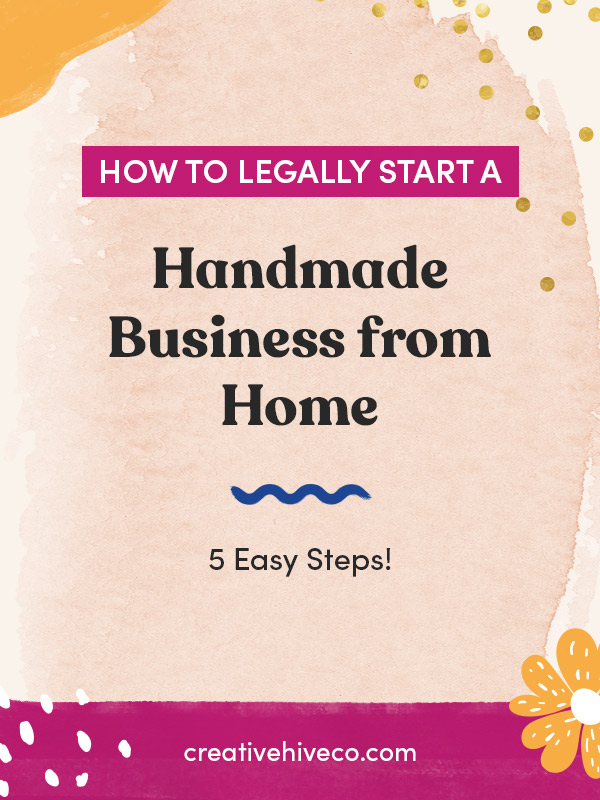I want to help you build a sustainable, profitable handmade business that makes you consistent income and sales. I only ever teach or recommend marketing, social media, pricing, production and branding tips that I’ve personally used successfully in my own 7-figure handmade businesses.
I'm Mei, from Los Angeles!
Read More
Popular Posts You'll Love
Looking for something?
Categories
starting a business
get more traffic
running a business
make more sales
branding
growing a business
mindset & productivity
podcasts
pricing & money
product photography
reviews
selling on etsy
selling on amazon
social media
selling wholesale
- Facebook0
- Twitter25
- Pinterest1.9K
- 1.9Kshares
I know the legal paperwork involved with starting a handmade business online might be confusing, but you don’t need to register for an expensive LLC if you’re just starting out.
In this post, I’ll walk you through the 5 legal steps to set up your handmade business as quickly and inexpensively as possible.
Many of you are looking to turn your hobby or craft into an income and have been asking me about the legal requirements of running a handmade business from home or whether you need to open an LLC. The good news is that you won’t need an expensive LLC and it’s actually surprisingly easy and inexpensive to legally start a business by following the steps I’ll be sharing with you today.
Quick Disclaimer Before We Get Started
As you know, I’m not a lawyer or a financial advisor. I’m just sharing what I know has worked for me and thousands of other sellers following official documentation online.
If you’re looking for legal advice, I recommend consulting with your local government or lawyer for the most accurate and personalized information to you.
Also, I’ll be showing you how to legally set up your handmade business in the United States. If you don’t live in the US, the process may be kind of similar, but you’re going to have to look into it yourself for your specific country.
Sole Proprietorship vs. LLC
Alright, so the type of business I recommend for new sellers is a “Sole Proprietorship.” Many of you will have heard of it before, as it’s considered one of the easiest types of businesses to start in the US.
Unlike corporations or LLC’s, you don’t have to register with the state, which means it’s very inexpensive and easy to set up when compared to an LLC.
The main difference as a sole proprietor is that you will be personally liable for any debts, lawsuits, or taxes your business faces, but that really shouldn’t put you off. There are something like 23 million sole proprietorships in the US today, which makes up about 70% of all US businesses, so it’s really nothing new.
One of the top benefits of being a sole proprietor is that you have full authority over your own business, which basically makes you your own boss.
They’re also incredibly easy to set up and, compared to an LLC which can cost $1000 just to get registered, sole proprietorships are practically free to start except for a few other separate fees we’ll get into later on in this post.
Another cool benefit of running your business as a sole proprietorship is that you’ll pay lower taxes especially since you’re just getting started with building your income, and they’re a lot less complicated to file compared to an LLC or corporation because the IRS doesn’t even require your balance sheets when tax time comes around. You can pretty much do everything yourself which will save you the additional cost of needing an accountant as well.
One of the main disadvantages of a sole proprietorship is that you will be held liable for any debts or lawsuits with your personal assets, but the good news is that you can eliminate most of those risks by getting insurance, which I’ll talk about later.
Another thing to consider is that you may have some trouble raising startup capital because many banks require businesses to incorporate before they’ll lend them any money, but for most of you guys that shouldn’t be an issue right now.
I think the pros of starting out as a sole proprietorship far outweigh the cons, but again, I’m not a lawyer, so if you need more specific information, I recommend you do your own research online or consult with an expert.
That being said, once you’ve decided a sole proprietorship is right for your handmade business, here are the 5 simple steps you need to take to get set up.
Step 1: Register Your Name
The good news about a sole proprietorship is that you won’t need to spend any money on formally incorporating your business, which can save you a few thousand dollars, but you’ll probably need to register your business name.
As a sole proprietor, you are the business, so the legal name of your business is automatically your personal name. That means if you decide to use your full name as the brand, or at least include it in your business name, then you may not need to register.
For example, you could run your business as “Tiara Brown’s Necklaces” without needing to legally register your business name.
If you named your business “Tiara’s Necklaces,” you would still need to register because you’re not including your full name.
If like most sellers, you want to do business under a different name, you’ll need to register a fictitious name or what’s known as a “DBA”(Doing Business As).
First, you want to check your name is available which you can easily do on the United States Patent and Trademark Office website.
Once you’ve made sure your name is available, you can file for a DBA with your local or county agency. The filing fee will vary by state, but it is usually something very cheap like $20 or so.
Keep in mind though, registering a DBA is not the same as registering a trademark. We’re just checking online to make sure your name is available and not being used by other businesses.
Most sellers don’t find it necessary when just starting out, but if for some reason you did want to protect your intellectual property, you can always file for a trademark at the patent office.
Keep in mind, it’s not legally necessary and can be pretty pricey for new sellers. I don’t recommend it to 99% of sellers.
Step 2: Get Your Business Permits & Licenses
Once you’ve registered your DBA, you’ll need to get a business license.
Every locality has its own regulations regarding a business license or permits for home businesses. To find out what licensing your business is required to have, just call your county or city clerk’s office and ask whether you need one.
The process is usually as simple as filling out a one-page form and filing fees will usually be anywhere from $50-100 dollars.
Just in case, you’ll want to ask your local government about any other permits & licenses needed to run your specific type of business, like with a food business, you’ll need special licenses just for that.
Chances are you won’t need any extra stuff unless you’re working with food or something similarly regulated.
Step 3: Get an EIN Number
You’ll want to get an employer identification number.
If you operate alone, you might not need an employee EIN and can operate and file taxes under your social security number.
But as soon as you hire an employee, or independent contractor or set up a retirement plan, you must file for an employer identification number.
They’re free and you can get one on the IRS website.

Step 4: Get a Separate Business Bank Account
You’re not legally required to have a separate bank account for your business, but I still recommend it because it will allow you to keep personal and business money separate from one another.
Plus, you’ll know month-to-month whether you’re operating at a profit or a loss by just glancing at your account.
Having a separate bank account also helps you file your taxes more easily.
This bank account doesn’t have to be a special “business” specific one. It can literally be a regular personal checking account with the bank you already use.
The important part here is that it’s a separate account from your personal money.
Step 5: Get Insurance
Because one of the biggest risks to starting a sole proprietorship is the liability you’ll have as an owner, you’ll want to get private insurance to protect your personal assets.
The easiest way to eliminate that when you’re just starting out is to get a general liability.
The one I recommend is ACT Insurance, because it is specifically tailored for artists, crafters, handmade jewelers, sculptors, clothing vendors, potters, art & craft show vendors, and more.
For an annual fee, these guys will cover your supplies, equipment, products, and any operations revolving around your business, allowing you to sell your products online, at a physical store, at a show or a market.
And that’s it! That’s how easy and inexpensive it is to start a handmade business with all the legal and financial steps taken care of.
From here on out, you can operate more smoothly and professionally––and don’t forget to pay your taxes!
This post was highly requested, so leave me a comment below if you have other posts you want to see me write for you.

Leave a Comment
Liked this article? Share it!
Unlock a Profitable Handmade Business
in Just 12 Weeks Without Using Etsy
or Social Media
FREE WORKSHOP
This workshop is for anyone who makes and sells a handmade or physical product, including jewelry designers, artists, paper designers, bath & body product makers and more!
What You'll Discover
The #1 mistake people make with Etsy & social media that causes shops to FLOP
The secret to making it with your handmade shop so it's no longer just a hobby
How to make sales in your handmade shop with ease so you can finally get to 6-figures
TAKE ME THERE
Your email address will not be published. Required fields are marked *
Leave a Reply Cancel reply
About
Blog
A Sale A Day
Student Login
Free Class
Contact
Terms
Become A Student
Watch On YouTube
Student Reviews
See My Handmade Shop!




I love that registering the business name was listed first, I’ve had cases of people who had their intellectual property stolen because they didn’t register their business.
Thank you so much for this information. I was feeling very overwhelmed with all the information out there. Your concise information was extremely helpful.
This program works out to be over $3000.00 in total
We are barely keeping up now. 58 a week is a whole lot. Do you have a monthly program. Maybe 100.00 A month
The HVAC field is booming, but without an HVAC license, you’re limiting your growth. Being licensed improves your professional reputation and helps you meet all the state’s technical and safety regulations. Most clients won’t even consider an unlicensed technician due to the risks involved. With licensing, you show that you’re serious about your trade and qualified to handle major systems safely.
Before reading this, I underestimated how important the right licensing is in construction. This post helped me see how crucial it is to get the proper Construction License, especially to avoid fines and build credibility with clients and subcontractors.